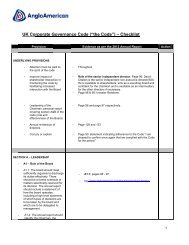Anglo American Annual Report 2012
Anglo American Annual Report 2012
Anglo American Annual Report 2012
- No tags were found...
You also want an ePaper? Increase the reach of your titles
YUMPU automatically turns print PDFs into web optimized ePapers that Google loves.
FINANCIAL STATEMENTSNOTES TO THE FINANCIAL STATEMENTS1. ACCOUNTING POLICIESBasis of preparationThe financial statements have been prepared in accordance with InternationalFinancial <strong>Report</strong>ing Standards (IFRS) and IFRS Interpretations Committee(IFRIC) interpretations as adopted for use by the European Union, with thoseparts of the Companies Act 2006 applicable to companies reporting underIFRS and with the requirements of the Disclosure and Transparency rules ofthe Financial Services Authority in the United Kingdom as applicable toperiodic financial reporting. The financial statements have been preparedunder the historical cost convention as modified by the revaluation of pensionassets and liabilities and certain financial instruments. A summary of theprincipal Group accounting policies is set out below.The preparation of financial statements in conformity with generally acceptedaccounting principles requires the use of estimates and assumptions thataffect the reported amounts of assets and liabilities at the date of the financialstatements and the reported amounts of revenues and expenses during thereporting period. Although these estimates are based on management’s bestknowledge of the amount, event or actions, actual results ultimately may differfrom those estimates.Going concernThe directors have, at the time of approving the financial statements, areasonable expectation that the Company and the Group have adequateresources to continue in operational existence for the foreseeable future.Thus the going concern basis of accounting in preparing the financialstatements continues to be adopted. Further details are contained in theDirectors’ report on page 128.Changes in accounting policies and disclosuresA number of amendments to accounting standards issued by the InternationalAccounting Standards Board (IASB) were applicable from 1 January <strong>2012</strong>.They have not had a material impact on the accounting policies, methods ofcomputation or presentation applied by the Group.Changes in estimatesDue to the nature of Platinum in-process inventories being contained in weirs,pipes and other vessels, physical counts only take place annually, except inthe Precious Metal Refinery which take place once every three years (thelatest being in 2010). Consequently, the Platinum business runs a theoreticalmetal inventory system based on inputs, the results of previous physicalcounts and outputs. Once the results of the physical count are finalised, thevariance between the theoretical count and actual count is investigated andrecorded as a change in estimate.During the year ended 31 December <strong>2012</strong>, the change in estimate followingthe annual physical count has had the effect of increasing the value ofinventory by $172 million (2011: $61 million), resulting in the recognitionof a gain in the income statement.Basis of consolidationThe financial statements incorporate a consolidation of the financial statementsof the Company and entities controlled by the Company (its subsidiaries). Controlis achieved where the Company has the power to govern the financial andoperating policies of an investee entity so as to obtain benefits from its activities.The results of subsidiaries acquired or disposed of during the year areincluded in the income statement from the effective date of acquisition orup to the effective date of disposal, as appropriate.Where necessary, adjustments are made to the results of subsidiaries, jointventures and associates to bring their accounting policies into line with thoseused by the Group. Intra-group transactions, balances, income and expensesare eliminated on consolidation, where appropriate.For non-wholly owned subsidiaries, a share of the profit or loss for thefinancial year and net assets or liabilities is attributed to the non-controllinginterests as shown in the income statement and balance sheet.AssociatesAssociates are investments over which the Group is in a position to exercisesignificant influence, but not control or joint control, through participation inthe financial and operating policy decisions of the investee. Typically theGroup owns between 20% and 50% of the voting equity of its associates.Investments in associates are accounted for using the equity method ofaccounting except when classified as held for sale. The Group’s share ofassociates’ net income is based on their most recent audited financialstatements or unaudited interim statements drawn up to the Group’s balancesheet date.The total carrying values of investments in associates represent the cost ofeach investment including the carrying value of goodwill, the share of postacquisition retained earnings, any other movements in reserves and any longterm debt interests which in substance form part of the Group’s netinvestment. The carrying values of associates are reviewed on a regular basisand if an impairment in value has occurred, the carrying value is impaired inthe period in which the relevant circumstances are identified. The Group’sshare of an associate’s losses in excess of its interest in that associate is notrecognised unless the Group has an obligation to fund such losses.Unrealised gains arising from transactions with associates are eliminatedagainst the investment to the extent of the Group’s interest in the investee.Unrealised losses are eliminated in the same way, but only to the extent thatthere is no evidence of impairment.Jointly controlled entitiesA jointly controlled entity is an entity in which the Group holds a long terminterest and shares joint control over strategic, financial and operatingdecisions with one or more other venturers under a contractual arrangement.The Group’s share of the assets, liabilities, income, expenditure and cashflows of such jointly controlled entities are accounted for using proportionateconsolidation. Proportionate consolidation combines the Group’s share of theresults of the joint venture entity on a line by line basis with similar items in theGroup’s financial statements.Jointly controlled operationsThe Group has contractual arrangements with other participants to engagein joint activities other than through a separate entity. The Group includes itsassets, liabilities, expenditure and its share of revenue in such joint ventureoperations with similar items in the Group’s financial statements.Revenue recognitionRevenue is derived principally from the sale of goods and is measured at thefair value of consideration received or receivable, after deducting discounts,volume rebates, value added tax and other sales taxes. Sales of concentrate arestated at their invoiced amount which is net of treatment and refining charges.A sale is recognised when the significant risks and rewards of ownership havepassed. This is usually when title and insurance risk have passed to thecustomer and the goods have been delivered to a contractually agreed location.Revenue from metal mining activities is based on the payable metal sold.Sales of certain commodities are provisionally priced such that the price is notsettled until a predetermined future date based on the market price at that time.Revenue on these sales is initially recognised (when the above criteria are met)at the current market price. Provisionally priced sales are marked to market ateach reporting date using the forward price for the period equivalent to thatoutlined in the contract. This mark to market adjustment is recognised in revenue.Revenues from the sale of material by-products are included within revenue.Where a by-product is not regarded as significant, revenue may be creditedagainst the cost of sales.Interest income is accrued on a time basis, by reference to the principaloutstanding and at the effective interest rate applicable.Dividend income from investments is recognised when the shareholders’rights to receive payment have been established.Business combinations and goodwill arising thereonThe identifiable assets, liabilities and contingent liabilities of a subsidiary,a joint venture entity or an associate, which can be measured reliably, arerecorded at their provisional fair values at the date of acquisition. Goodwillis the fair value of the consideration transferred (including contingentconsideration and previously held non-controlling interests) less the fair valueof the Group’s share of identifiable net assets on acquisition.Where a business combination is achieved in stages, the Group’s previously heldinterests in the acquired entity are remeasured to fair value at the acquisitiondate and the resulting gain or loss is recognised in the income statement.142 <strong>Anglo</strong> <strong>American</strong> plc <strong>Annual</strong> <strong>Report</strong> <strong>2012</strong>



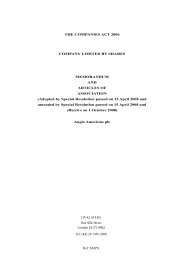
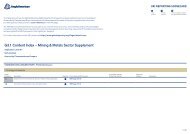
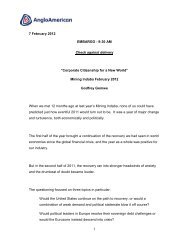


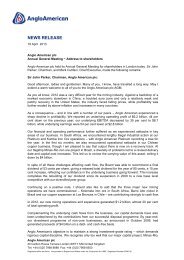
![English PDF [ 189KB ] - Anglo American](https://img.yumpu.com/50470814/1/184x260/english-pdf-189kb-anglo-american.jpg?quality=85)



![pdf [ 595KB ] - Anglo American](https://img.yumpu.com/49420483/1/184x260/pdf-595kb-anglo-american.jpg?quality=85)
![pdf [ 1.1MB ] - Anglo American](https://img.yumpu.com/49057963/1/190x240/pdf-11mb-anglo-american.jpg?quality=85)
